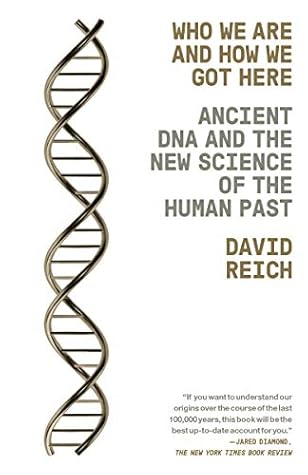More on this book
Community
Kindle Notes & Highlights
by
David Reich
Read between
December 28, 2020 - January 1, 2021
Ten generations back, for example, the number of ancestral stretches of DNA is around 757 but the number of ancestors is 1,024, guaranteeing that each person has several hundred ancestors from whom he or she has received no DNA whatsoever.
If the ancient DNA studies of the last few years have shown anything clearly, it is that the geographic distribution of people living today is often misleading about the dwelling places of their ancestors.
Human history is full of dead ends, and we should not expect the people who lived in any one place in the past to be the direct ancestors of those who live there today.
Analyzing our data, he found that about ten thousand years ago there were at least four major populations in West Eurasia—the farmers of the Fertile Crescent, the farmers of Iran, the hunter-gatherers of central and western Europe, and the hunter-gatherers of eastern Europe. All these populations differed from one another as much as Europeans differ from East Asians today. Scholars interested in trying to create ancestry-based racial classifications, had they lived ten thousand years ago, would have categorized these groups as “races,” even though none of these groups survives in unmixed form
...more
Analysis of ancient DNA data shows that western European hunter-gatherers around eight thousand years ago had blue eyes but dark skin and dark hair, a combination that is rare today.
Surprisingly, the ancient DNA revolution, through its discovery of the pervasiveness of ghost populations and their mixture, is fueling a critique of race that has been raised by scholars in the past, but was never prominent because of a lack of support from hard scientific facts.37 By demonstrating that the genetic fault lines in West Eurasia between ten thousand and four thousand years ago were entirely different from today’s, the ancient DNA revolution has shown that today’s classifications do not reflect fundamental “pure” units of biology. Instead, today’s divisions are recent phenomena,
...more
The extraordinary fact that emerges from ancient DNA is that just five thousand years ago, the people who are now the primary ancestors of all extant northern Europeans had not yet arrived.
Iñigo Olalde, a postdoctoral scientist, analyzed the data to show that individuals in Iberia were genetically indistinguishable from the people who had preceded them and who were not buried in a Bell Beaker culture style. But Bell Beaker–associated individuals in central Europe were extremely different, with most of their ancestry of steppe origin, and little if any ancestry in common with individuals from Iberia associated with the Bell Beaker culture. So, in contrast to what happened with the spread of the Corded Ware culture from the east, the initial spread of the Bell Beaker culture
...more
the single most important source of ancestry across northern Europe today is the Yamnaya or groups closely related to them.
Ancient DNA has established major migration and mixture between highly divergent populations as a key force shaping human prehistory, and ideologies that seek a return to a mythical purity are flying in the face of hard science.
Some placed the ancestral homeland of the Indo-Aryans in northeast Europe, including Germany. They also adopted features of Vedic mythology as their own, calling themselves Aryans after the term in the Rig Veda, and appropriating the swastika, a traditional Hindu symbol of good fortune.
This pattern of sex-asymmetric population mixture is disturbingly familiar. Consider African Americans.


